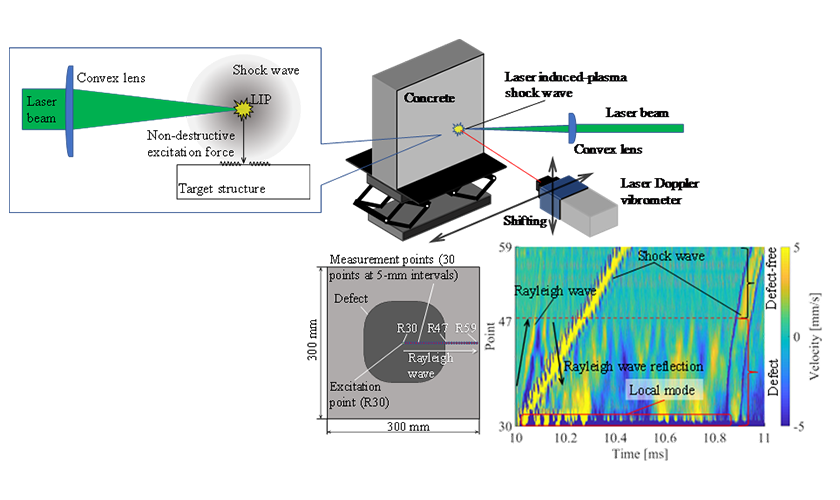A Laser-Quick and Non-Destructive Method to Detect Cracks in Concrete Structures
2022/02/24
- Research
Scientists analyze vibration patterns resulting from laser-induced shock waves to detect defects in concrete structures

Title:Experimental setup used to perform the non-destructive telemetry test
Caption:Scientists fromShibaura Institute of Technology (SIT)developed a new non-destructive method to investigate cracks in concrete structures. They used shockwaves generated close to the surface of the structure by focusing the beam from a high-powered laser, and defects were detected by analyzing the vibrations induced in the structure.
Credit:ProfessorNaoki Hosoya from SIT, Japan
Usage restrictions:Copyright restricted
Conventionally, defects in concrete structures are detected using the acoustic test called the “hammering method” performed by certified building inspectors. However, these tests take time to complete and as with most skill-based techniques, the effectiveness of the test is dependent on the expertise of the inspector. Moreover, as the number of aging infrastructures continues to rise, a method of inspection that is fast and reliable is paramount for ensuring the safe operation and long-term use of the structure.
An alternative inspection method for testing involves generating shock waves near the surface of the concrete structure. The shock waves induce vibrations on the structure which can be analyzed to detect defects. However, in such tests, it is necessary to generate shock waves that do not damage the structure. In this regard, laser-induced plasma (LIP) shock wave excitation has shown great promise. The technique has been used to detect defects in a variety of structures, ranging from pipes to fruit surfaces. In this method, the shock waves are generated by colliding laser-generated plasma with air.
In a new study, researchers from Shibaura Institute of Technology and the National Institutes for Quantum Science and Technology, Japan, tested the effectiveness of this method at detecting cracks in concrete structures. “We used LIP shock waves as a non-contact, non-destructive impulse excitation. This allows for remote and completely non-destructive detection of defects in concrete structures,” explains Naoki Hosoya, a Professor at the Department of Engineering Science and Mechanics at Shibaura Institute of Technology and the corresponding author of the study. Their findings have been published in the International Journal of Mechanical Sciences.
To evaluate the new method, the researchers exposed a concrete block that had an artificially created defect to a shock wave generated by a high-power pulsed laser. The vibrations were then analyzed at multiple points on the concrete surface inside and outside the defect area. The analysis revealed the presence of Rayleigh waves at the site of the defect. These are surface waves that move at a faster velocity than other shock waves. The researchers were able to successfully determine the defect areas by detecting the points where these Rayleigh waves were reflected. “Defects in the concrete specimen can be detected and the location of the approximate boundary can be determined using the propagation of Rayleigh waves,” explains Prof. Hosoya.
By visualizing Rayleigh waves, defects in a structure can be detected much faster than with other telemetric methods which analyze vibrations, making it a useful method for non- destructive testing of concrete structures. “The advantage of using Rayleigh waves to detect defects is that fewer measurement points are necessary compared to measuring the natural mode. Additionally, the time required for defect detection can be shortened. Visualizing Rayleigh waves propagation has potential for practical detection of the configurations and defects in concrete,” elaborates Prof. Hosoya.
In conclusion, the use of LIP shock waves to assess cracks in concrete structures is a safe and rapid method that can be used to maintain infrastructure and prevent structural failure.
Reference
| Title of original paper: | Defect detection of concrete in infrastructure based on Rayleigh wave propagation generated by laser-induced plasma shock waves |
| Journal | International Journal of Mechanical Sciences |
| DOI: | 10.1016/j.ijmecsci.2021.107039 |
Funding Information
The authors thank the Japan Society for the Promotion of Science for their support under the Grant-in Aid for Scientific Research programs (Grant No. JP21H01279).Contact
Planning and Public Relations Section
3-7-5 Toyosu, Koto-ku, Tokyo 135-8548, Japan (2F the Centennial Main Building, Toyosu Campus)
TEL:+81-(0)3-5859-7070 / FAX:+81-(0)35859-7071
E-mail:koho@ow.shibaura-it.ac.jp